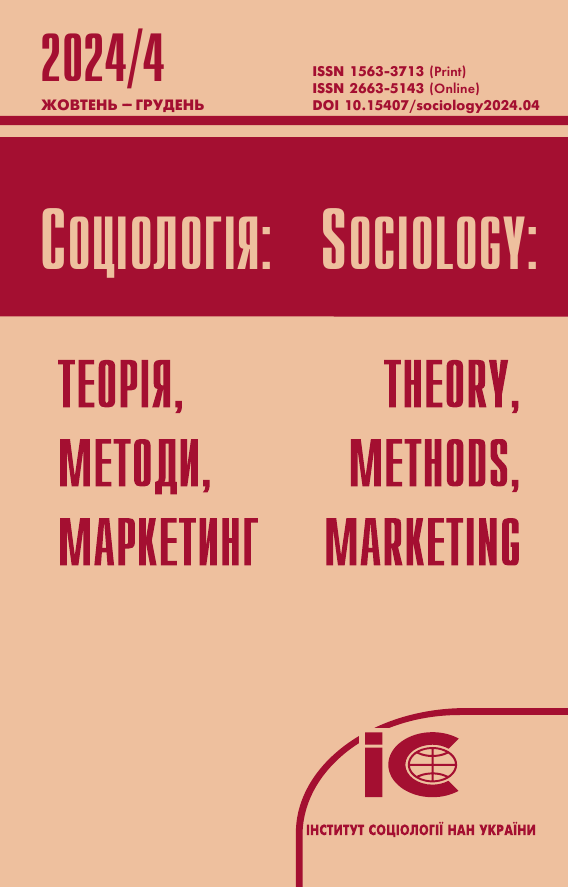Narratives instead of scenarios: what was wrong with forecasting the all-out Russian invasion of Ukraine?
stmm. 2025 (1): 79-89
DOI https://doi.org/10.15407/sociology2025.01.079
Full text:
YURIY SAVELYEV, Doctor of Sciences in Sociology, Candidate of Sciences in Philosophy, Professor at the Department of Methodology and Methods of Sociological Research, Faculty of Sociology, Taras Shevchenko National University of Kyiv (Volodymyrska St., 60, Kyiv, 01033)
yursave@knu.ua
https://orcid.org/0000-0003-2023-4472
https://www.scopus.com/authid/detail.uri?authorId=57189896685
OLEKSANDRA BAHATSKA, Student at Faculty of Philosophy, Taras Shevchenko National University of Kyiv (Volodymyrska St., 60, Kyiv, 01033)
aleksandra.alia@gmail.com
Based on the analysis of media reports in January–February 2022 (up to 02/24/2022), the article reveals which forecasts of an all-out Russian invasion were prevalent before its beginning. Quantitative and qualitative analysis of the statements and interviews of 54 Ukrainian and Russian media personalities known in Ukraine, political figures and experts, allowed to determine the validity of their forecast and identify the main arguments and narratives used by them.
If, in general, the prognosis found in the media reports at the beginning of 2022 was characterized by maximum uncertainty, then the divergence of predictions depended on the position of media personalities in the political landscape and their ideology. Representatives of the Ukrainian authorities mostly avoided a clear answer regarding the possibility of a large-scale Russian offensive. This was complemented by an active denial of the likelihood of further Russian aggression by the Kremlin speakers and pro-Kremlin mass media, which was also largely supported by pro-Russian political parties in Ukraine. Ukrainian independent experts and commentators as well as Russian radical nationalists mostly correctly predicted the course of events.
Arguments used in forecasting, including those projections provided by professional experts, were based on the popular narratives not the results of scenario analysis. Some of these narratives were shared by different groups of media commentators who might have opposing ideological positions. The quality of the forecast would probably have been better if media commentators had considered possible scenarios instead of narratives.
Keywords: analysis of media reports, narratives, mixed and qualitative research, Russian invasion of Ukraine, scenarios
References
-
Junio, T.J., Mahnken, T.G. (2013). Conceiving of future war: The promise of scenario analysis for international relations. International Studies Review, 15(3), 374-395. https://doi.org/10.1111/misr.12061
-
Ruser, A. (2015). Sociological quasi-labs: The case for deductive scenario development. Current sociology, 63(2), 170-181. https://doi.org/10.1177/0011392114556581
-
Savelyev, Yu. (2023). Untruthful claims, real war, dire consequences: understanding the narrative of the Russian invasion of Ukraine. Journal of Contemporary Central and Eastern Europe, 31(2), 467-480. https://doi.org/10.1080/25739638.2023.2198831
- Sus, M., Hadeed, M. (2020). Theory-infused and policy-relevant: On the usefulness of scenario analysis for international relations. Contemporary Security Policy, 41(3), 432-455. https://doi.org/10.1080/13523260.2020.1730055
Received 14.08.2024
Narratives instead of scenarios: what was wrong with forecasting the all-out Russian invasion of Ukraine?
stmm. 2025 (1): 79-89
DOI https://doi.org/10.15407/sociology2025.01.079
Full text:
YURIY SAVELYEV, Doctor of Sciences in Sociology, Candidate of Sciences in Philosophy, Professor at the Department of Methodology and Methods of Sociological Research, Faculty of Sociology, Taras Shevchenko National University of Kyiv (Volodymyrska St., 60, Kyiv, 01033)
yursave@knu.ua
https://orcid.org/0000-0003-2023-4472
https://www.scopus.com/authid/detail.uri?authorId=57189896685
OLEKSANDRA BAHATSKA, Student at Faculty of Philosophy, Taras Shevchenko National University of Kyiv (Volodymyrska St., 60, Kyiv, 01033)
aleksandra.alia@gmail.com
Based on the analysis of media reports in January–February 2022 (up to 02/24/2022), the article reveals which forecasts of an all-out Russian invasion were prevalent before its beginning. Quantitative and qualitative analysis of the statements and interviews of 54 Ukrainian and Russian media personalities known in Ukraine, political figures and experts, allowed to determine the validity of their forecast and identify the main arguments and narratives used by them.
If, in general, the prognosis found in the media reports at the beginning of 2022 was characterized by maximum uncertainty, then the divergence of predictions depended on the position of media personalities in the political landscape and their ideology. Representatives of the Ukrainian authorities mostly avoided a clear answer regarding the possibility of a large-scale Russian offensive. This was complemented by an active denial of the likelihood of further Russian aggression by the Kremlin speakers and pro-Kremlin mass media, which was also largely supported by pro-Russian political parties in Ukraine. Ukrainian independent experts and commentators as well as Russian radical nationalists mostly correctly predicted the course of events.
Arguments used in forecasting, including those projections provided by professional experts, were based on the popular narratives not the results of scenario analysis. Some of these narratives were shared by different groups of media commentators who might have opposing ideological positions. The quality of the forecast would probably have been better if media commentators had considered possible scenarios instead of narratives.
Keywords: analysis of media reports, narratives, mixed and qualitative research, Russian invasion of Ukraine, scenarios
References
-
Junio, T.J., Mahnken, T.G. (2013). Conceiving of future war: The promise of scenario analysis for international relations. International Studies Review, 15(3), 374-395. https://doi.org/10.1111/misr.12061
-
Ruser, A. (2015). Sociological quasi-labs: The case for deductive scenario development. Current sociology, 63(2), 170-181. https://doi.org/10.1177/0011392114556581
-
Savelyev, Yu. (2023). Untruthful claims, real war, dire consequences: understanding the narrative of the Russian invasion of Ukraine. Journal of Contemporary Central and Eastern Europe, 31(2), 467-480. https://doi.org/10.1080/25739638.2023.2198831
- Sus, M., Hadeed, M. (2020). Theory-infused and policy-relevant: On the usefulness of scenario analysis for international relations. Contemporary Security Policy, 41(3), 432-455. https://doi.org/10.1080/13523260.2020.1730055
Received 14.08.2024
